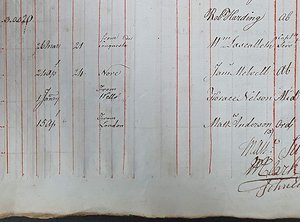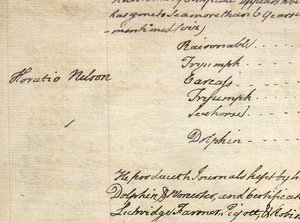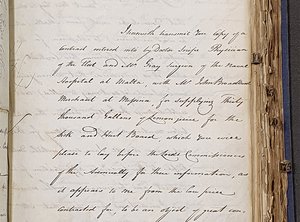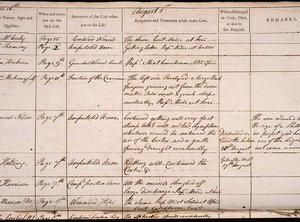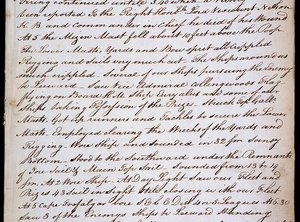Record revealed
List of HMS Victory's killed and wounded at the Battle of Trafalgar
We hold many records relating to one of the most famous naval battles in history, the Battle of Trafalgar, in which Lord Admiral Nelson died. But he was not the only one. The surgeon’s journal for HMS Victory records the lesser-known sailors who also lost their lives.
Important information
This article contains descriptions of injuries.
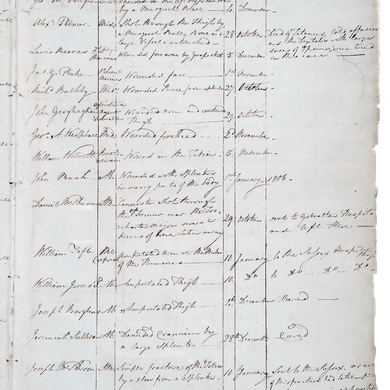
Image 1 of 1
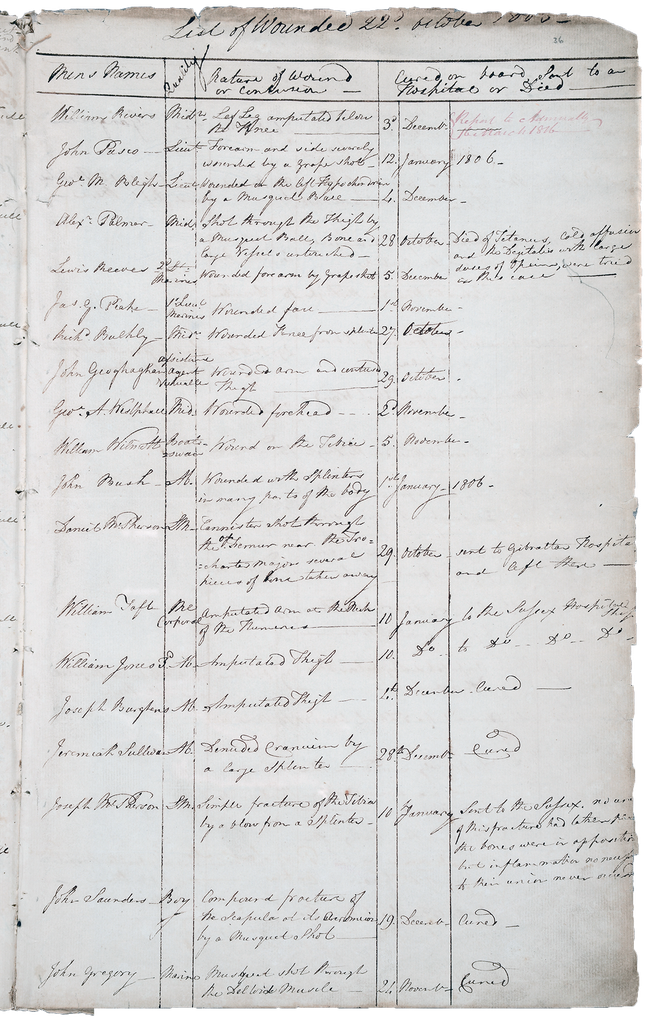
Journal recording details of sailors taken ill or wounded on the HMS Victory at the Battle of Trafalgar.
Partial transcript
Folios 36-38: List of wounded 22 October 1805.
William Rivers, midshipman; nature of wound or contusion: left leg amputated below the knee; cured on board, sent to hospital or died, report to Admiralty 16 March 1816.
John Pasco, lieutenant; nature of wound or contusion: forearm and side severely wounded by a grape shot; cured on board, sent to hospital or died, 12 January 1806.
George M Bligh, lieutenant; nature of wound or contusion: wounded on the left hypochondrian by a musquet ball; cured on board, sent to hospital or died, 4 December [1805].
Alexander Palmer, midshipman; nature of wound or contusion: shot through the thigh by a musquet ball, bone and large vessels untouched; cured on board, sent to hospital or died, 28 October [1805] died of tetanus, cold affusion and [?] with large doses of opium, were tried in this case.
Lewis Reeves, second lieutenant, marine; nature of wound or contusion: wounded forearm by grapeshot; cured on board, sent to hospital or died, 5 December [1805].
James G Peake, first lieutenant, marine; nature of wound or contusion: wounded face; cured on board, sent to hospital or died, 1 December [1805].
Richard Bulkly, midshipman; nature of wound or contusion: wounded knee from splinter; cured on board, sent to hospital or died, 27 October [1805].
Why this record matters
Date: 1805
In 1703, the Sick and Hurt Board, one of the administrative bodies that oversaw the Royal Navy, proposed that surgeons serving on ships keep a journal recording details of sailors taken ill or wounded and the methods used to cure them. These journals would become the basis for verifying claims ‘made for disabilities arising from illness or accidents on duty’. Such journals offer a fascinating insight into the health of men serving on Royal Navy ships and the treatments used to cure them.
One of the most significant examples of such a journal was that kept by William Beatty, Surgeon of HMS Victory at the Battle of Trafalgar, which took place on 21 October 1805. In it, Beatty records the names of those wounded, detailing their horrific wounds sustained in combat typical for those involved in such naval battles on wooden ships of the time, and the names of those killed.
Beatty recorded that the total wounded of HMS Victory’s crew of 832 in the Battle of Trafalgar was 102, and ‘of these five died on board, and one at the Naval hospital at Gibraltar, all the others got well on board excepting five of the worst cases left at Gibraltar and five patients who were not recovered of their wounds when HMS Victory was put out of commission in January [1806] following at Chatham, they were therefore sent to HMS Sussex hospital ship at Sheerness’.
Some of Beatty’s entries make eye-opening reading. With regards to Alexander Palmer, Midshipman, Beatty states that Palmer was shot through the thigh by a musket ball, bone and large vessels untouched. Yet, on 28 October 1805, Palmer sadly died of tetanus, even though large doses of opium were used to try and save him. John Bush, Able Seaman, was discharged cured on 1 January 1806 having been wounded with splinters in many parts of his body.
Numerous amputations were also performed by Beatty, including one on William Rivers, Midshipman, whose left leg was amputated below the knee. Rivers was discharged cured on 3 December 1806. Miraculously, Beatty somehow managed to keep alive Jeremiah Sullivan, Able Seaman, whose cranium was ‘denuded’ by a large splinter.
It is testimony to Beatty’s life-saving medical skills and abilities that fatalities were kept low, and even more praiseworthy given that many of his interventions took place during battle, with all the chaos that enveloped HMS Victory.
One surprising omission from Beatty’s journal is its most famous and celebrated casualty, Horatio Nelson. Beatty later addressed this omission detailing his account of Nelson’s injuries, a musket-shot wound, and treatment in his bestselling, Authentic Narrative of the Death of Lord Admiral Horatio Nelson, published in 1807.
